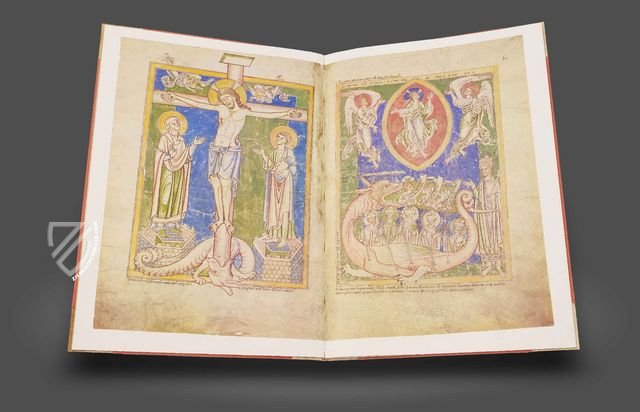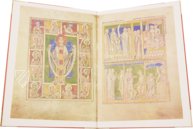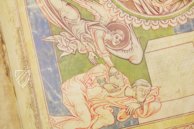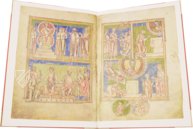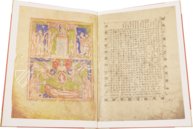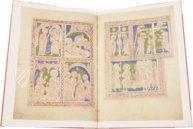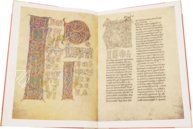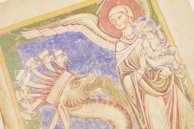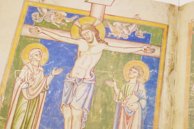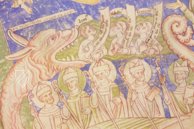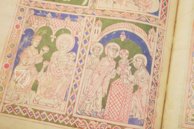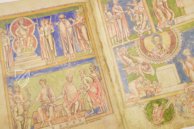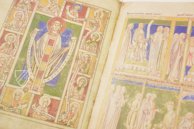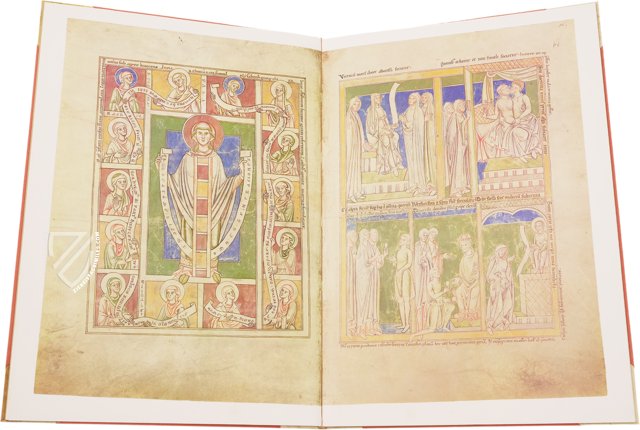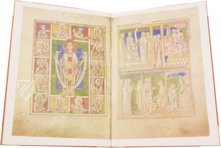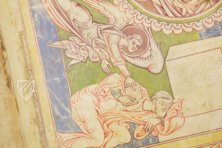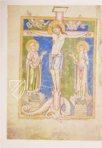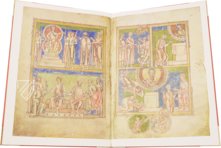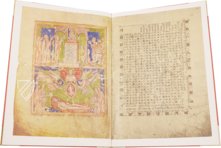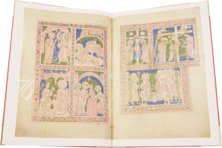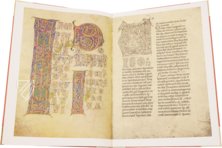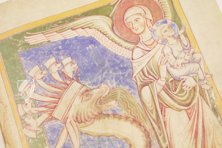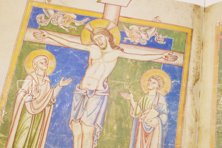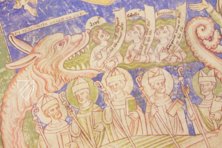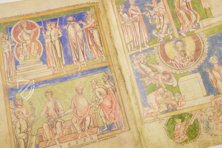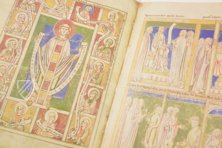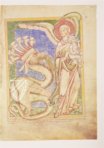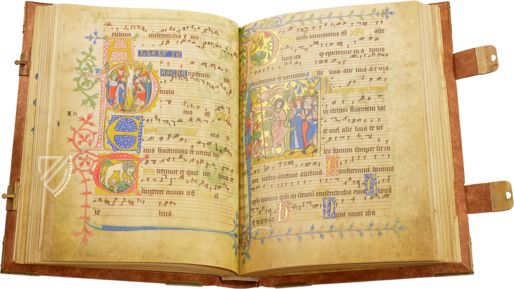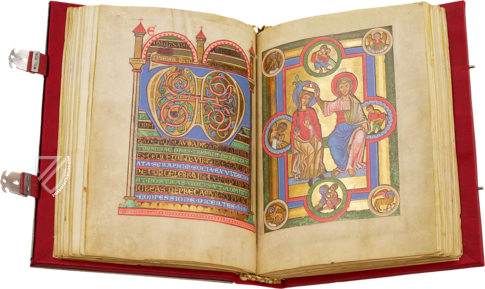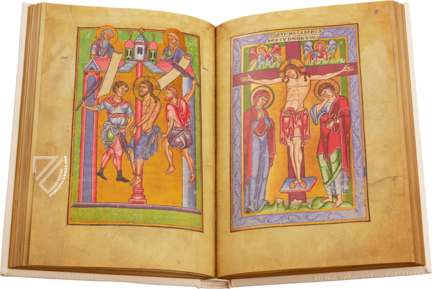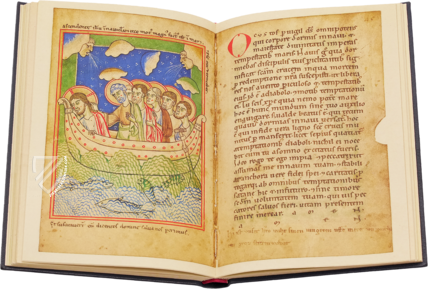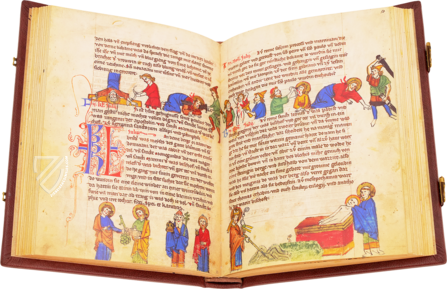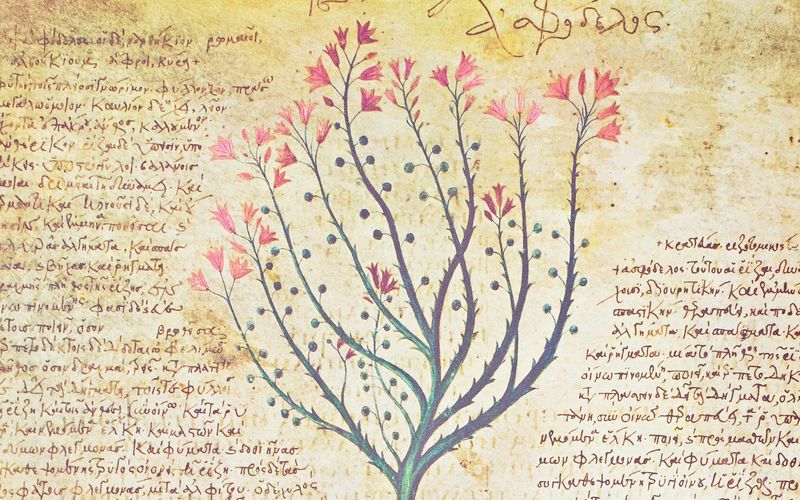Matutinal Book from Scheyern
(1,000€ - 3,000€)
The Matutinal Book from Scheyern is an important testimonial to late Romanesque illumination in Germany as well as an important contemporary document. It originated in Scheyern Abbey between 1215 and 1225 at the behest of Abbot Conrad I as part of the furnishings for a new church dedicated to the Virgin Mary. The large, richly illuminated codex was primarily used for Matins, the nightly service celebrated by the monastic community. Its pages exhibit evidence of extensive and consistent use including wax or tallow stains. Aside from the Matins text, it contains a table for calculating the date of Easter, a liturgical calendar with various feast and saints’ days, a so-called epilogue, catalog of rulers, the annals of Scheyern Abbey, three poetic legends, notes on donations and the monastery’s income, and a picture cycle. The iconographically and art-historically important miniatures include a depiction of the Woman of the Apocalypse and the Dragon. The codex is thus valuable both as a work of art and as a collection of historical records.
Matutinal Book from Scheyern
A matutinal book contains the readings recited by a monastic community at the nightly choral prayer known as Matins and as such typically has a large format so that it can be read by numerous people from a distance. The readings are typically preceded by a series of non-liturgical texts that reflect the intellectual and economic interests of the monastery. What distinguishes the Matutinal Book from Scheyern above others are two cycles of colored pen and ink drawings that are both monumental in size – 55 x 39 cm – and exceptional in quality. The leaves show the traces of intensive use, including occasional wax or tallow stains. It was created sometime between 1215, when the new church was consecrated after much of the monastery was destroyed in a fire, and 1225 at the behest of Abbot Conrad I von Luppburg (r. 1206–73). The manuscript was acquired by what is now the Bavarian State Library in Munich in 1803.
A Rare and Splendid Compilation
Aside from the basic text of the Matins, the manuscript contains a computational table for calculating the date of Easter, a calendar of feasts, an epilogue, a catalog of rulers, the annals of Scheyern, three poetic legends, and notes concerning the traditions and income of the monastery. The first of the two picture cycles focuses on the Virgin Mary’s role as the Co-Redemptrix and includes a narrative of Theophilus and the pregnant abbess as well as the famous full-page miniature of the Woman of the Apocalypse and the Dragon. Seven scenes from the life of the Virgin Mary comprise the second picture cycle, which concludes with a miniature of St. Martin and St. Peter opposite a miniature of an enthroned Virgin Mary with the patron of the manuscript lying prostrate, his hands folded in prayer at her feet. Stylistically, the simultaneously lively and monumental pictures of the first cycle are oriented towards contemporary painting from Regensburg-Prüfening, while the pictures of the second cycle are characterized by the so-called Zackenstil, which combines the influence of both the Middle Rhenish and Byzantine traditions.
Codicology
- Alternative Titles
- Matutinalbuch aus Scheyern
- Size / Format
- 108 pages / 45.0 × 60.0 cm
- Origin
- Germany
- Date
- 1215–1225
- Epochs
- Style
- Genre
- Language
- Illustrations
- 25 plates, 16 of them colored; 16 black and white illustrations
- Patron
- Abbot Conrad I of Scheyern
- Artist / School
- Frater Chuonradus sacerdos and other hands
Matutinal Book from Scheyern
Historiated “D” Initial
Appearing on a decorative page with two other large initials, this splendid “D” introduces the abbreviated phrase Dominica quarta ante nativitatem domini or “The fourth Sunday before Christmas”. It consists of a shaded brown initial with a green and blue background. Five animals including four dragons in red, blue, and light brown as well as a light brown dog can be found among the flowering tendrils in grey-blue, red-brown, green, and white that wind their way around the initial. Dragons are a popular decorative theme throughout the manuscript and appear in both its initials and miniatures.
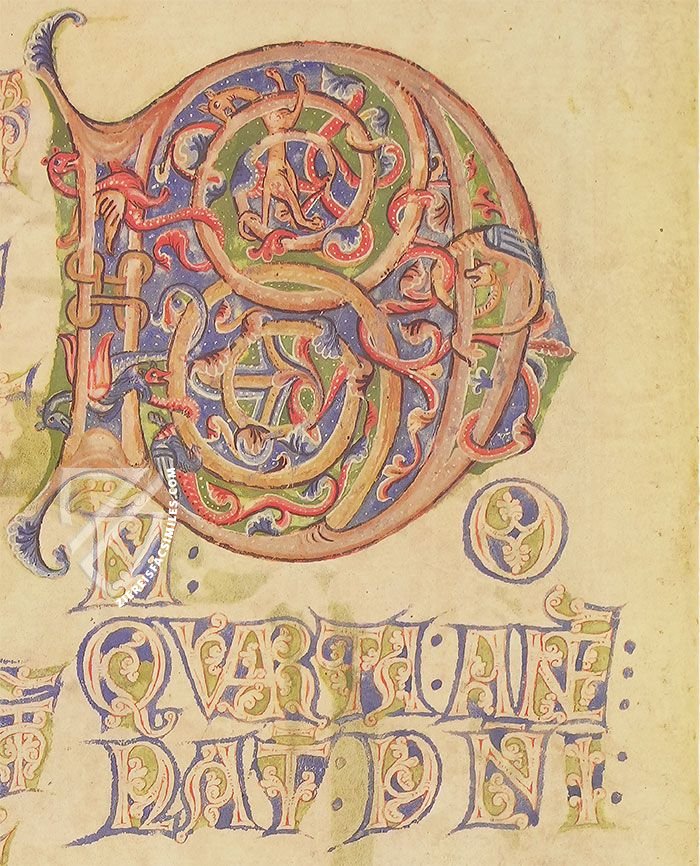
Matutinal Book from Scheyern
The Woman of the Apocalypse and the Dragon
Revelation 12 in a scene that is reduced to the three essential figures: the Woman of the Apocalypse (representing either the Virgin Mary or God’s people), her son with cross-halo and book (representing Jesus), and the seven-headed dragon who wants to eat him (representing Satan). The dragon spews a river of water from its mouth to sweep her away but the eagle’s wings she has been given allow her to flee.
Elements of the nascent Gothic style appear in this Romanesque miniature including the Woman’s stylized, angular garment fall of folds typical of the zackenstil. Furthermore, while the dragon is presented in a more conventional flat profile, she is depicted in a dynamic “three-quarter view” with one foot stepping out of the frame as she looks back over her shoulder, an artistic pattern indicating escape from a pursuer that goes back to Ancient Greek vases.
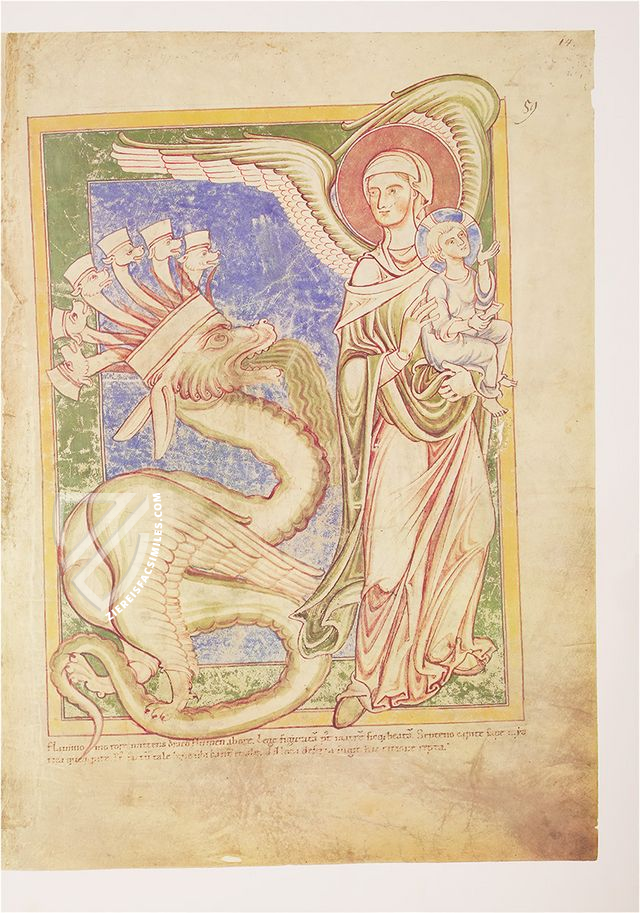
#1 Das Matutinalbuch aus Scheyern: Faksimile der Bildseiten aus dem Codex Latinus Monacensis 17401 der Bayerischen Staatsbibliothek München
Language: German
(1,000€ - 3,000€)
- Treatises / Secular Books
- Apocalypses / Beatus
- Astronomy / Astrology
- Bestiaries
- Bibles / Gospels
- Chronicles / History / Law
- Geography / Maps
- Saints' Lives
- Islam / Oriental
- Judaism / Hebrew
- Single Leaf Collections
- Leonardo da Vinci
- Literature / Poetry
- Liturgical Manuscripts
- Medicine / Botany / Alchemy
- Music
- Mythology / Prophecies
- Psalters
- Other Religious Books
- Games / Hunting
- Private Devotion Books
- Other Genres
- Afghanistan
- Armenia
- Austria
- Belgium
- Belize
- Bosnia and Herzegovina
- China
- Colombia
- Costa Rica
- Croatia
- Cyprus
- Czech Republic
- Denmark
- Egypt
- El Salvador
- Ethiopia
- France
- Germany
- Greece
- Guatemala
- Honduras
- Hungary
- India
- Iran
- Iraq
- Israel
- Italy
- Japan
- Jordan
- Kazakhstan
- Kyrgyzstan
- Lebanon
- Liechtenstein
- Luxembourg
- Mexico
- Morocco
- Netherlands
- Palestine
- Panama
- Peru
- Poland
- Portugal
- Romania
- Russia
- Serbia
- Spain
- Sri Lanka
- Sweden
- Switzerland
- Syria
- Tajikistan
- Turkey
- Turkmenistan
- Ukraine
- United Kingdom
- United States
- Uzbekistan
- Vatican City
- A. Oosthoek, van Holkema & Warendorf
- Aboca Museum
- Ajuntament de Valencia
- Akademie Verlag
- Akademische Druck- u. Verlagsanstalt (ADEVA)
- Aldo Ausilio Editore - Bottega d’Erasmo
- Alecto Historical Editions
- Alkuin Verlag
- Almqvist & Wiksell
- Amilcare Pizzi
- Andreas & Andreas Verlagsbuchhandlung
- Archa 90
- Archiv Verlag
- Archivi Edizioni
- Arnold Verlag
- ARS
- Ars Magna
- ArtCodex
- AyN Ediciones
- Azimuth Editions
- Badenia Verlag
- Bärenreiter-Verlag
- Belser Verlag
- Belser Verlag / WK Wertkontor
- Benziger Verlag
- Bernardinum Wydawnictwo
- BiblioGemma
- Biblioteca Apostolica Vaticana (Vaticanstadt, Vaticanstadt)
- Bibliotheca Palatina Faksimile Verlag
- Bibliotheca Rara
- Boydell & Brewer
- Bramante Edizioni
- Bredius Genootschap
- Brepols Publishers
- British Library
- C. Weckesser
- Caixa Catalunya
- Canesi
- CAPSA, Ars Scriptoria
- Caratzas Brothers, Publishers
- Carus Verlag
- Casamassima Libri
- Centrum Cartographie Verlag GmbH
- Chavane Verlag
- Christian Brandstätter Verlag
- Circulo Cientifico
- Club Bibliófilo Versol
- Club du Livre
- CM Editores
- Collegium Graphicum
- Collezione Apocrifa Da Vinci
- Comissão Nacional para as Comemorações dos Descobrimentos Portugueses
- Coron Verlag
- Corvina
- CTHS
- D. S. Brewer
- Damon
- De Agostini/UTET
- De Nederlandsche Boekhandel
- De Schutter
- Deuschle & Stemmle
- Deutscher Verlag für Kunstwissenschaft
- DIAMM
- Droz
- E. Schreiber Graphische Kunstanstalten
- Ediciones Boreal
- Ediciones Grial
- Ediclube
- Edições Inapa
- Edilan
- Editalia
- Edition Deuschle
- Edition Georg Popp
- Edition Leipzig
- Edition Libri Illustri
- Editiones Reales Sitios S. L.
- Éditions de l'Oiseau Lyre
- Editions Medicina Rara
- Editorial Casariego
- Editorial Mintzoa
- Editrice Antenore
- Editrice Velar
- Edizioni Edison
- Egeria, S.L.
- Eikon Editores
- Electa
- Emery Walker Limited
- Enciclopèdia Catalana
- Eos-Verlag
- Ephesus Publishing
- Ernst Battenberg
- Eugrammia Press
- Extraordinary Editions
- Fackelverlag
- Facsimila Art & Edition
- Facsimile Editions Ltd.
- Facsimilia Art & Edition Ebert KG
- Faksimile Verlag
- Feuermann Verlag
- Folger Shakespeare Library
- Franco Cosimo Panini Editore
- Friedrich Wittig Verlag
- Fundación Hullera Vasco-Leonesa
- G. Braziller
- Gabriele Mazzotta Editore
- Gebr. Mann Verlag
- Gesellschaft für graphische Industrie
- Getty Research Institute
- Giovanni Domenico de Rossi
- Giunti Editore
- Graffiti
- Grafica European Center of Fine Arts
- Guido Pressler
- Guillermo Blazquez
- Gustav Kiepenheuer
- H. N. Abrams
- Harrassowitz
- Harvard University Press
- Helikon
- Hendrickson Publishers
- Henning Oppermann
- Herder Verlag
- Hes & De Graaf Publishers
- Hoepli
- Holbein-Verlag
- Houghton Library
- Hugo Schmidt Verlag
- Idion Verlag
- Il Bulino, edizioni d'arte
- ILte
- Imago
- Insel Verlag
- Insel-Verlag Anton Kippenberger
- Instituto de Estudios Altoaragoneses
- Instituto Nacional de Antropología e Historia
- Introligatornia Budnik Jerzy
- Istituto dell'Enciclopedia Italiana - Treccani
- Istituto Ellenico di Studi Bizantini e Postbizantini
- Istituto Geografico De Agostini
- Istituto Poligrafico e Zecca dello Stato
- Italarte Art Establishments
- Jan Thorbecke Verlag
- Johnson Reprint Corporation
- Josef Stocker
- Josef Stocker-Schmid
- Jugoslavija
- Karl W. Hiersemann
- Kasper Straube
- Kaydeda Ediciones
- Kindler Verlag / Coron Verlag
- Kodansha International Ltd.
- Konrad Kölbl Verlag
- Kurt Wolff Verlag
- La Liberia dello Stato
- La Linea Editrice
- La Meta Editore
- Lambert Schneider
- Landeskreditbank Baden-Württemberg
- Leo S. Olschki
- Les Incunables
- Liber Artis
- Library of Congress
- Libreria Musicale Italiana
- Lichtdruck
- Lito Immagine Editore
- Lumen Artis
- Lund Humphries
- M. Moleiro Editor
- Maison des Sciences de l'homme et de la société de Poitiers
- Manuscriptum
- Martinus Nijhoff
- Maruzen-Yushodo Co. Ltd.
- MASA
- Massada Publishers
- McGraw-Hill
- Metropolitan Museum of Art
- Militos
- Millennium Liber
- Müller & Schindler
- Nahar - Stavit
- Nahar and Steimatzky
- National Library of Wales
- Neri Pozza
- Nova Charta
- Oceanum Verlag
- Odeon
- Orbis Mediaevalis
- Orbis Pictus
- Österreichische Staatsdruckerei
- Oxford University Press
- Pageant Books
- Parzellers Buchverlag
- Patrimonio Ediciones
- Pattloch Verlag
- PIAF
- Pieper Verlag
- Plon-Nourrit et cie
- Poligrafiche Bolis
- Presses Universitaires de Strasbourg
- Prestel Verlag
- Princeton University Press
- Prisma Verlag
- Priuli & Verlucca, editori
- Pro Sport Verlag
- Propyläen Verlag
- Pytheas Books
- Quaternio Verlag Luzern
- Reales Sitios
- Recht-Verlag
- Reichert Verlag
- Reichsdruckerei
- Reprint Verlag
- Riehn & Reusch
- Roberto Vattori Editore
- Rosenkilde and Bagger
- Roxburghe Club
- Salerno Editrice
- Saltellus Press
- Sandoz
- Sarajevo Svjetlost
- Schöck ArtPrint Kft.
- Schulsinger Brothers
- Scolar Press
- Scrinium
- Scripta Maneant
- Scriptorium
- Shazar
- Siloé, arte y bibliofilia
- SISMEL - Edizioni del Galluzzo
- Sociedad Mexicana de Antropología
- Société des Bibliophiles & Iconophiles de Belgique
- Soncin Publishing
- Sorli Ediciones
- Stainer and Bell
- Studer
- Styria Verlag
- Sumptibus Pragopress
- Szegedi Tudomànyegyetem
- Taberna Libraria
- Tarshish Books
- Taschen
- Tempus Libri
- Testimonio Compañía Editorial
- Thames and Hudson
- The Clear Vue Publishing Partnership Limited
- The Facsimile Codex
- The Folio Society
- The Marquess of Normanby
- The Richard III and Yorkist History Trust
- Tip.Le.Co
- TouchArt
- TREC Publishing House
- TRI Publishing Co.
- Trident Editore
- Tuliba Collection
- Typis Regiae Officinae Polygraphicae
- Union Verlag Berlin
- Universidad de Granada
- University of California Press
- University of Chicago Press
- Urs Graf
- Vallecchi
- Van Wijnen
- VCH, Acta Humaniora
- VDI Verlag
- VEB Deutscher Verlag für Musik
- Verlag Anton Pustet / Andreas Verlag
- Verlag Bibliophile Drucke Josef Stocker
- Verlag der Münchner Drucke
- Verlag für Regionalgeschichte
- Verlag Styria
- Vicent Garcia Editores
- W. Turnowski Ltd.
- W. Turnowsky
- Waanders Printers
- Wiener Mechitharisten-Congregation (Wien, Österreich)
- Wissenschaftliche Buchgesellschaft
- Wissenschaftliche Verlagsgesellschaft
- Wydawnictwo Dolnoslaskie
- Xuntanza Editorial
- Zakład Narodowy
- Zollikofer AG

